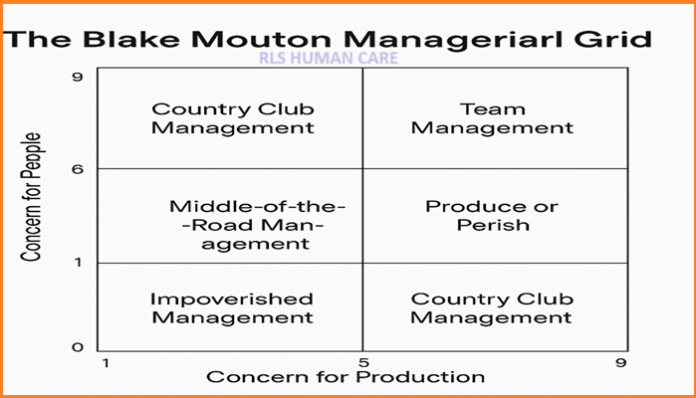The Blake Mouton Managerial Grid (also known as the Blake and Mouton Management Grid) is a well-known model developed by Robert R. Blake and Jane S. Mouton in the early 1960s. It is used to analyze different leadership styles based on a manager’s concern for people versus their concern for production.
This framework helps leaders understand their current style and evaluate how they can become more effective by adjusting their management approach.
Contents
The Two Axes of the Grid
The grid plots two key concerns:
- Concern for People (Y-axis): How much a leader values the needs, interests, and personal development of their team.
- Concern for Production (X-axis): How much a leader emphasizes efficiency, productivity, and high task performance.
Each axis is scaled from 1 (low) to 9 (high), producing five major leadership styles based on the intersection of these concerns.
The Five Management Styles
1. Impoverished Management (1,1)
- Low concern for people, low concern for production
In this style, the manager exerts minimal effort. Tasks are poorly managed, and employees receive little support. This approach leads to low productivity and morale.
🔹 Key Traits:
- Disengaged leadership
- Lack of commitment
- Minimal supervision
🔹 Impact: Often results in disorganized teams, high turnover, and a lack of direction.
2. Produce or Perish Management (9,1)
- High concern for production, low concern for people
This authoritarian style prioritizes output above all else. Managers push for results and may use fear or punishment to motivate. Employees’ needs are often ignored, leading to low morale.
🔹 Key Traits:
- Task-driven
- Directive and controlling
- Low employee satisfaction
🔹 Impact: Can achieve short-term productivity but often at the cost of burnout and high staff turnover.
3. Country Club Management (1,9)
- High concern for people, low concern for production
Here, the manager is highly accommodating and focuses on creating a friendly work environment. However, productivity can suffer due to a lack of structure and direction.
🔹 Key Traits:
- Team harmony focused
- Avoids conflict
- Supportive but passive
🔹 Impact: Morale is usually high, but performance and goal achievement may lag.
4. Team Management (9,9)
- High concern for people, high concern for production
This is considered the ideal management style. The leader values both task achievement and team collaboration. They promote high levels of trust, respect, and shared commitment.
🔹 Key Traits:
- Collaborative
- Motivational and inspiring
- High standards, with high support
🔹 Impact: Leads to both high productivity and high employee satisfaction. Builds a strong, self-managing team culture.
5. Middle-of-the-Road Management (5,5)
- Moderate concern for both people and production
This style represents a compromise. Managers aim for acceptable performance while maintaining decent morale. However, this can lead to mediocrity as neither concern is fully addressed.
🔹 Key Traits:
- Balancing act
- Avoids extremes
- Focus on status quo
🔹 Impact: Stable but uninspired teams. Risk of missed opportunities for excellence.
The Blake Mouton Managerial Grid remains a powerful tool for diagnosing leadership styles. While different situations may require different approaches, the Team Management (9,9) style is generally seen as the most effective and sustainable. By understanding where they fall on the grid, leaders can take intentional steps to improve both team satisfaction and productivity.
Whether you’re leading a small team or managing an entire department, knowing your place on the grid is the first step toward becoming a better, more balanced leader.





